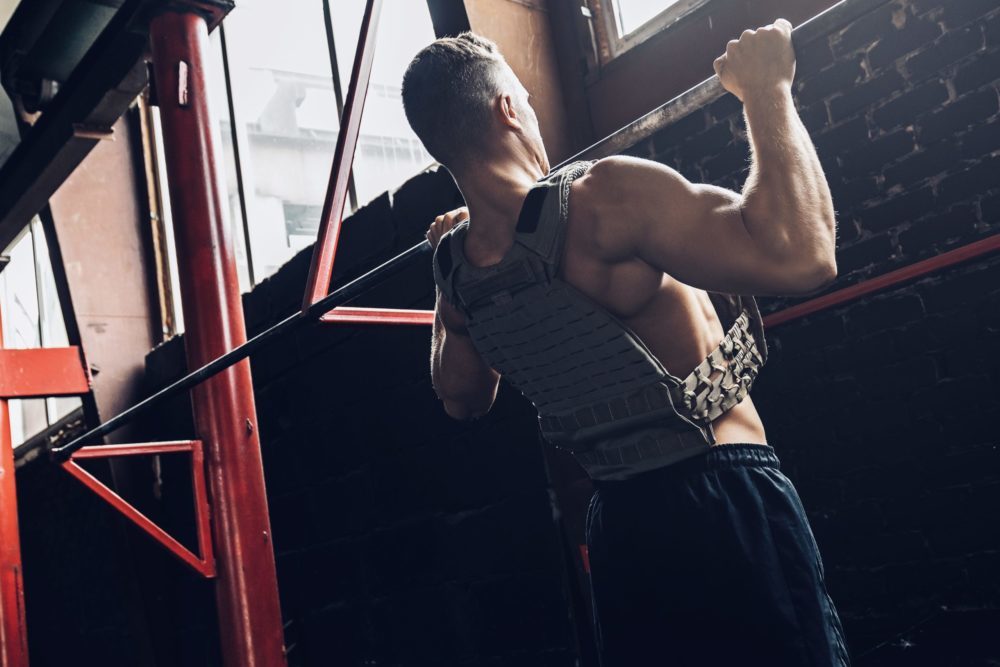Pull-ups are a classic bodyweight exercise and key component of many strength training programs. But as good as they are progress can often stall, leading to frustration, boredom and giving up.
Failure isn’t an option! Here’s an advanced technique that’ll help you break that barrier, set new pull-up PR’s, and improve your overall back strength and size.
Mechanical Drop-Sets
Mechanical drop-sets are pretty sadistic and a good intensity and muscle-building technique. They’re a form of drop-set where instead of stripping weight off the bar, say, you change the mechanics of the exercise in order to ween out extra reps and extend the set. You accumulate more reps and volume with the same weight.
Mechanical drop-sets typically consist of 3-4 variations of the same exercise, done back to back with the same resistance throughout. 70-85% of your 1RM is a good place to start for your first exercise, completing in the region of 5-10 reps.
Next, change to a mechanically more advantageous version of the same exercise and do as many as you can, say 4-7 reps. Next, change to an even more more advantageous version and maybe finish with 2-4 reps.
Designing a mechanical drop-set is actually really simple. You select 3-4 variation of the same exercise and place them in order of hardest to easiest. Have a brief “reset” between each exercise to offset fatigue slightly (10 seconds or so) but you never rest completely until the set is over. Here’s how your set will look:
- First exercise: Hardest x 5-10 reps
- Second exercise: Easier x AMGRAP (as many GOOD reps as possible, or just a few short)
- Third exercise: Easiest x AMGRAP
Applying mechanical drop-sets to pull-ups
Typical pull-ups include using a bar for overhand, underhand and neutral variations. And, are weakest to strongest in that order respectively. You’re able to lift the most weight in a neutral grip pull-up and least with an overhand grip. If you’re not the strongest with a neutral grip then it’s likely you have some structural weaknesses that need improving. But I digress.
Placing said pull-ups in that order will form a highly effective mechanical drop-set that’ll look like this:
- Overhand wide grip pull-ups x 5-10 reps, rest 10’s
- Underhand grip pull-ups x AMGRAP (as many GOOD reps as possible, or just a few short), rest 10’s
- Neutral grip pull-ups x AMGRAP, rest 2-3 minutes then repeat.
And here it is in action.
You could start with a slightly lower repetition range if you’d like, or even more. But the same principles apply. This is something i’ve employed in my own coaching practice for a long time, and with repeated success. It’ll allow you to accumulate a greater total volume of pull-ups, ultimately developing the necessary strength and coordination patterns that’ll skyrocket your pull-up performance.
Strength v.s. size
As a strength method with little gains in lean mass start with a weight that would allow you to get 4-6 reps with at the beginning. Your set might then look something like:
- Overhand wide grip pull-ups x 5 reps, rest 10’s
- Underhand grip pull-ups x 3, rest 10’s
- Neutral grip pull-ups x 1-2, rest 3-5 minutes then repeat.
As a protocol to build back size and width, begin with a weight that would allow you to get 8-10 reps with to start. Your set might then look something like this:
- Overhand wide grip pull-ups x 10 reps, rest 10’s
- Underhand grip pull-ups x 6-7, rest 10’s
- Neutral grip pull-ups x 4-5, rest 2 minutes then repeat.
Mechanical drop-set pull-ups are an awesome technique, and for some you might just stop there, head off and start busting them out. And I’m cool with that. But what if you want to know how to effectively progress weight over time? Or even if you’re not at the stage of full bodyweight yet?
Choosing the right weight is key, and no different whether you’re loading a bar or loading your own body. Here’s how (and feel free to skip the section that doesn’t apply to you).
Pull-ups for pros
With many bodyweight exercises it’s a simple case of finding the easiest way to add extra weight. There’s no “best” option, and oftentimes comes down to pure comfort or practicality.
For some, a weighted vest can achieve this, and is an efficient way to add tiny nuggets of weight over time – providing your vest is adjustable that-is. For others a dumbbell between your knees works well, and you like the ability to release the weight when you need to.
Arguably a dipping belt is one of the best options longterm, though, and will eventually allow you to be hitting those super heavy pull-ups without any limits. Stacking giant wheels as well as adding the little donut weight plates are just as easy.
Consider your body as a unit of weight. If you’re able to do 10 reps with your own weight then that probably represents 75% or so of your 1 rep max. Adding 10% extra to that will theoretically allow you to hit 5-6 reps – If you weighed 200lbs and could do 10 bodyweight reps, you should be able to do 5-6 with an extra 10lbs hanging off you.
Rep maxes and %1RM’s apply to barbells, dumbbells and cables just as much as they apply to your own bodyweight. If you need a chart to help this one’s pretty useful.

Unloading weight for beginners (bands are NOT the best option!)
The common method for assisting pull-ups is using the band-assisted method. Although I don’t think this is the worst idea in the world, I do think there are far more effective ways to build your pull-up strength than using bands.
Last week I wrote an article for t-nation.com detailing the exact reasons for this. I’m sure you’ll see that real soon, or may be in the future right now having read it already. There’s more detail there, but for now here’s a very brief explanation why I consider them to be overrated.
Imagine you’re performing a pull-up for just a second. Visualise the points in which each rep gets easiest and hardest. You don’t need a complex understanding of biomechanics to realise that the first few inches at the bottom are pretty easy. You then hit a rough patch somewhere near the middle, before right at the top getting easier again (usually at the point where your elbows pull down past level with your shoulders).
Now how does a band work and how does it assist in a pull-up? As a band is stretched as does it become stronger. In the case of a pull-up as the band hangs and stretches it will assist you the most. This happens most at the bottom of the pull-up where you’re also strongest.
Its level of assistance then decreases making the pull-up harder as you reach the hardest part (towards the middle), where eventually at the top it gives you very little assistance – where you’re strong(ish) but not as much as at the bottom.
That’s the very brief explanation, and as I said i’ve gone in to more detail elsewhere. But suffice to say assisting in this way with a band doesn’t match the strength profile of a pull-up. If anything the band would work the opposite way, and even then it wouldn’t be ideal. I’d go so far as to say that even the machines used to assist your pull-ups are better.
A better way to “assist” pull-ups
The best way to assist and build pull-up strength is by using isometric holds and eccentric variations. They’re better for developing the prerequisite muscle coordination patterns and have better transference. At the same time they’re an effective means to build foundational strength and add lean muscle tissue. They’re also useful for building the strength and resilience of your connective tissues.
Here are just a few eccentric training options. Keep in mind that these can be done with a bar in a rack, smith machine, or suspension trainer as well as using the rings like shown. You also have numerous grip options. For example you could perform a mechanical drop set combining the eccentrics below, while switching from overhand, to underhand and then neutral.
Ring Eccentric Pull-Ups
With these you’re lifting your full bodyweight on the lower and partial bodyweight on the way up. Ideally this would be controlled, from 2-6 seconds depending on your exact goals. These are suitable for even complete beginners who can do modified versions. While Moore advanced could even wear a weighted vest.
Your goal is to simply lift more on the way down than the way up, and make the most of the extra strength you have available during the eccentric phase of lifting. Building strength with these over time will transfer on to isometric and full hanging pull-ups.
1-Arm Eccentric Ring Pull
In much the same way as the above variation, these overload the eccentric portion but in a different way. This is sometimes referred to as the 2/1 technique. While you lift with two arms you then lower with just one. Your feet are kept on the floor throughout for stability, while you can choose to use them as much or little as you’d like. A highly effective and fun technique to incorporate in your training.
Roundup
The mechanical drop-set technique described can help you break through common pull-up barriers, while also building a bigger and stronger back. Knowing how to progress and load pull-ups over time, and the simple act of adding micro weight or rep progressions is a powerful tool. The principles used in barbell training apply just the same as the principles of effective bodyweight training.
If you have any questions about anything touched on in this article, or have any thoughts, please leave me a comment below.

